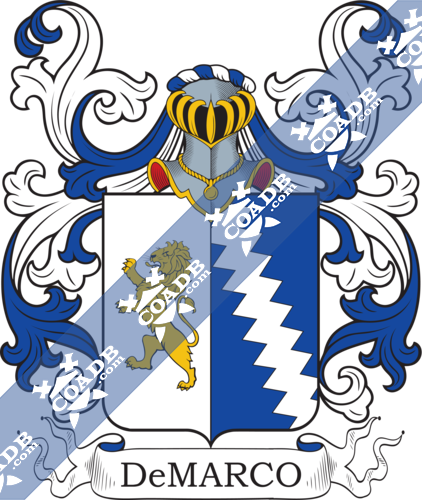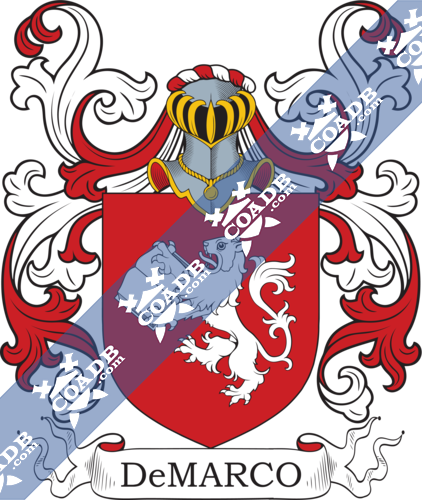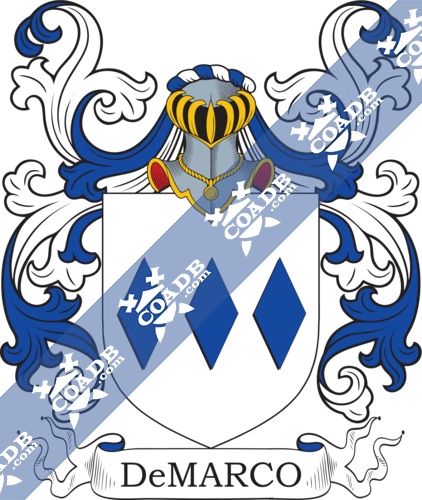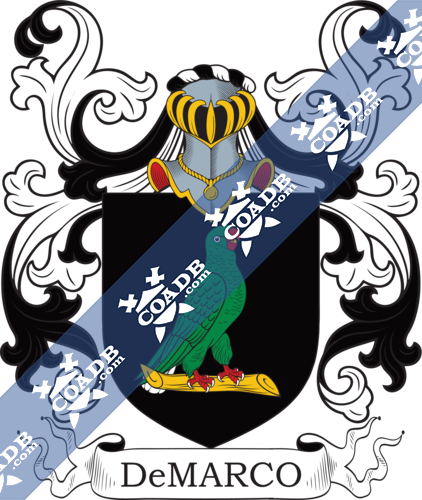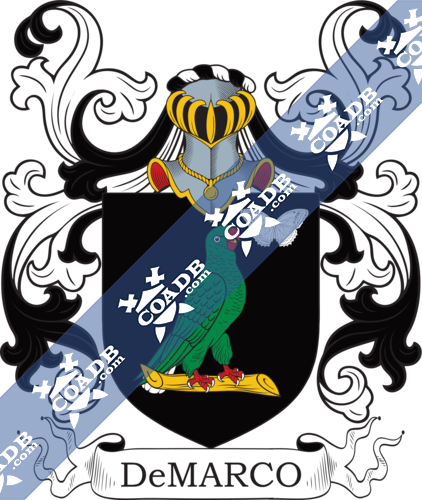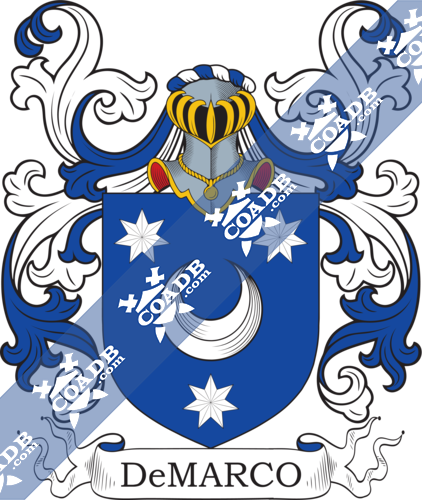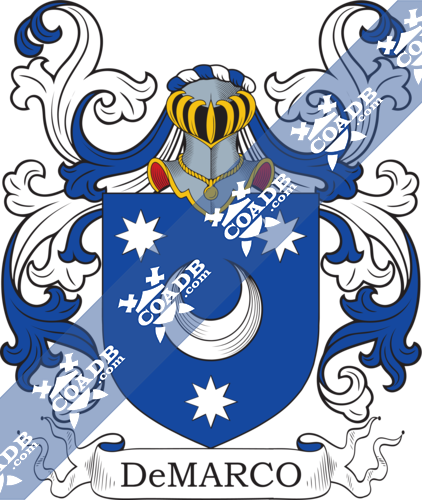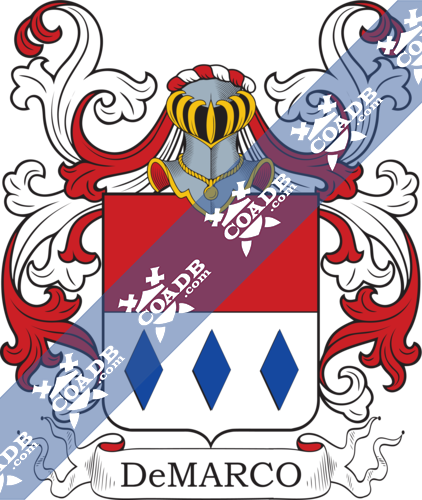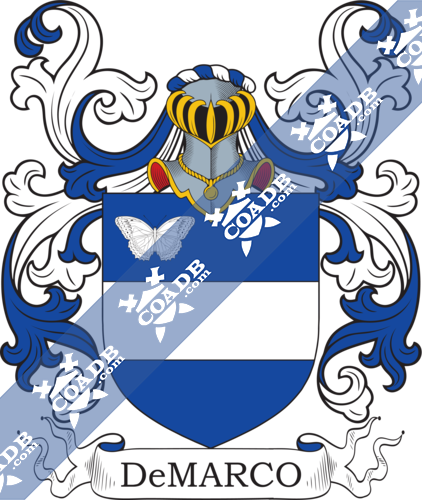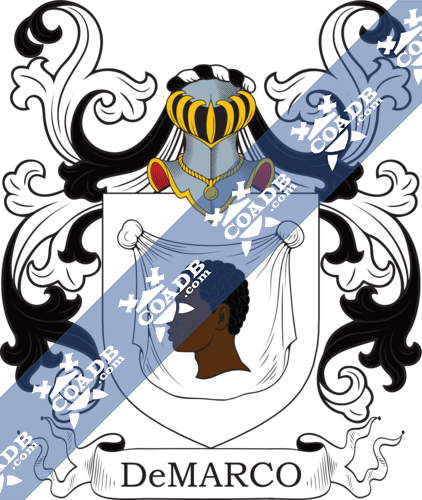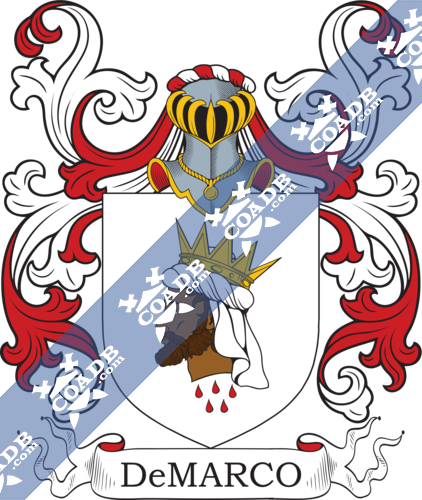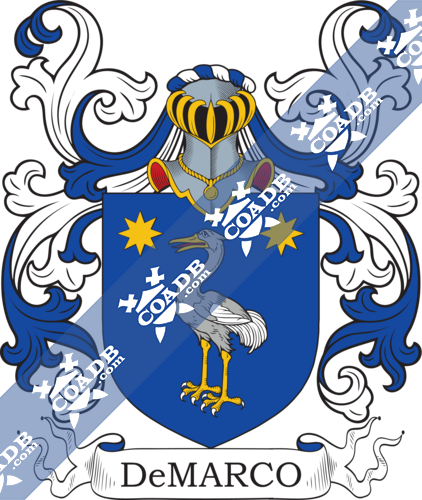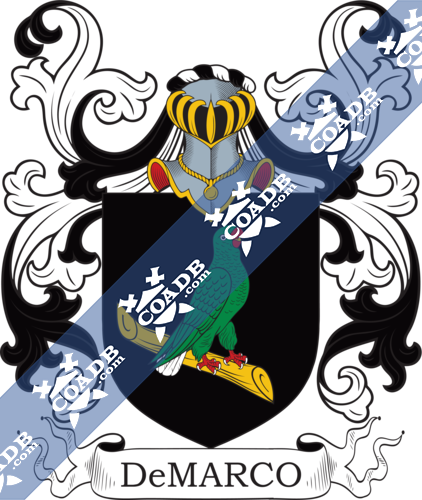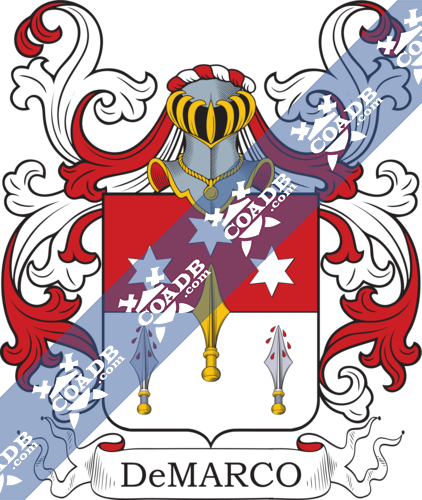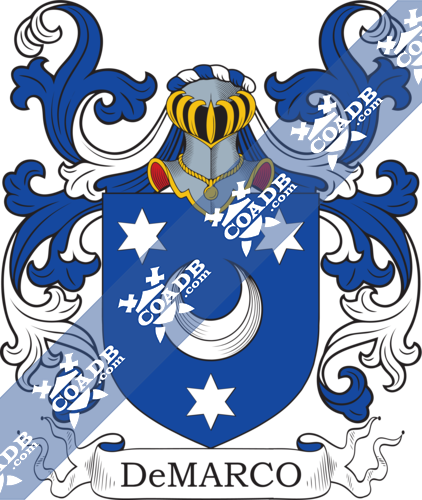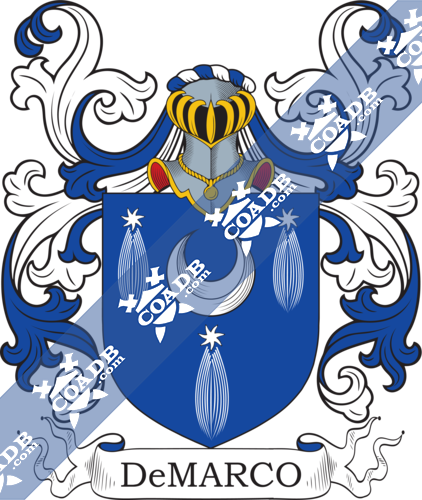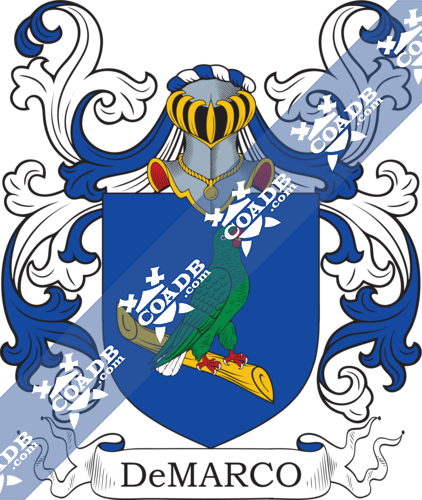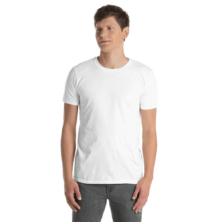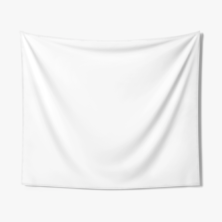Demarco Family Crest, Coat of Arms and Name History
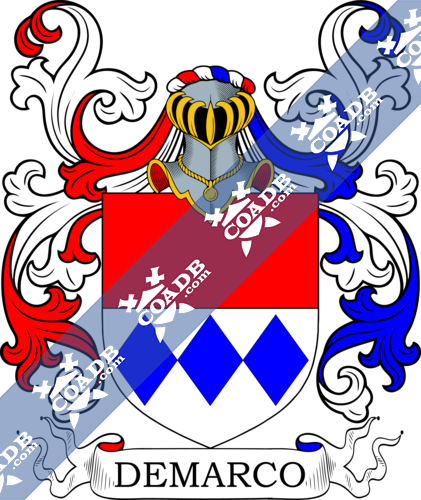
Demarco Coat of Arms Gallery
Don’t know which Coat of Arms is yours?
We can do a genealogical research. Find out the exact history of your family!
Learn MoreDEMARCO
The surname DeMarco is Italian in origin. It would be considered patronymic as it translates to mean “son of Marco.” Marco is a masculine given name found most commonly in Italy, Austria, Portugal, Switzerland, and the Netherlands. It derives its origins from the Latin name Marcus, the name Marcus was derived from the Roman god Mars.
In ancient Roman mythology, Mars was the god of war and agriculture. As a god of the military, he was seen as a keeper of peace, as a god of agriculture he was a protector of farms and farmers. In Roman mythology, he was seen as one of the most powerful gods and the father of Romulus who founded Rome and is said to have created its first senate and legions.
Surnames in Europe prior to the mid-sixteenth century were largely reserved for the noble class. In the small villages which existed during these earlier times, residents found little need for surnames as everyone in these communities knew each other and a given name would usually suffice. However, as population growth and expansions of villages gave way to towns and cities, for practical purposes it became necessary to add a qualifier to a people’s names to distinguish them, one from another and to make the keeping of tax, census, and immigration records easier. Therefore, the nobles’ practice of surnames gained in popularity.
In the creating of surnames for the masses, one person may have been identified by their given name plus their occupation while another may have been identified by their given name and one of their parent’s names. There was an endless supply from which surnames could be formed, in addition to the use of patriarchal/matriarchal names or reference to the individuals occupation, there were things such as defining physical traits, a familiar geographical location or a topographical landmark found near the individuals home or birthplace, the name of the village in which the person lived, and so much more.
There are over one hundred variations of the spelling of the surname including but not limited to; DeMarco; De Marco; Di Marco; De Marko; DeMarko; Marco; and Marcoz among others. The variation in spelling of both given and surnames during this time period can be attributed to a lack of continuity regarding guidelines for spelling which was compounded by the diversity of languages in use in European countries at this time. The earliest record of any variation of this surname is that of Heinrich Mark which appears in the charters for the town of Biberach, Germany dated 1390.
After the discovery of America and the British Commonwealth of countries; Canada, Australia, and New Zealand, it was not long before people began to immigrate to these outlying areas. Some of the first recorded immigrants to America bearing the surname was Prosper DeMarco who arrived in 1898 and settled in Mississippi. Francesco DeMarco landed and settled in Allegheny County, Pennsylvania in 1902. Anna DeMarco and her son Alfonso arrived in the United States in 1903. Fredrick DeMarco arrived and settled in Arizona in 1904 and Adam DeMarco arrived in America in 1907.
Worldwide, the highest concentration of people with the surname DeMarco are found in Argentina, the United States, Australia, Canada, and Italy. By state, the largest percentile of those with the surname DeMarco live in Connecticut, Massachusetts, New Hampshire, New Jersey, New York, and Pennsylvania.
There are many persons of note who bear the surname DeMarco. Richard DeMarco was born in Edinburgh, Scotland. He is an artist and promoter of the performing and visual arts. He opened his own theater gallery, the Richard DeMarco Gallery, in 1966 just three years after he co-founded the Traverse Theater in Edinburgh in 1963.
DeMarco used his gallery to help promote cultural links with artist from Eastern Europe, show casing such artist as Paul Neagu, Marina Abramovic, and Neue Slowenische Kunst. He also organized exhibitions of Polish, Romanian, and Yugoslavia artist and art. DeMarco is presented art exhibitions, conferences, plays, and concerts well into the thousands which have showcased artist and performers from over sixty countries.
DeMarco was knighted having received the Order of the British Empire and Commander of the British Empire.
Blazons & Genealogy Notes
1) (Di Marco) (di Messina) Originaria di Spagna, à fiorito fra la nobiltà di Messina nei secoli XV, XVI e XVII Spaccato; nel 1) di rosso pieno; nel 2) d’ argento, a tre fusi d’azzurro, accollati in fascia.
2) DeMarco di Messina e Palermo (Sicilia) – Spaccato; nel 1 di rosso pieno; nel 2 d’argento, a tre fusi d’azzurro, accollati in fascia. (Source: Crollalanza’s Diccionario Storico-Blasonico). English: Truncated; in the 1 of full red; in the silver 2, with three spindles of blue, accolades in the band.
3) DeMarco Patr. Di Barletta, Terlizzi, Bitritto e Barone di Terranova (Puglia e Sicilia) – Di Nero al pappagallo al naturale, rivoltato, fermo su di un tronco di pino di oro, messo in banda (Source: Padiglione’s Trenta centurie di Armi Gentilizie). English: of the black with the natural parrot, turned over, standing on a golden pine trunk, placed in band (Pavilion’s Thirty Centuries of Weapons)
4) DeMarco di Mistretta, Barone di Terranova (Sicilia) – Spaccato: nel 1 di rosso a tre stelle di argento male ordinate; nel 2 argento a tre ferri di lancia al naturale impugnanti e legati di rosso; alla terza di oro attraversante sullo spaccato. (Source: Padiglione’s Trenta centurie di Armi Gentilizie). English: truncated: in the 1st of red to three badly ordered silver stars; in the 2, silver, three-barreled spearheads in natural handrails and tied in red; at the third of gold crossing on the cutaway.
5) DeMarco di Terra d’Otranto (Puglia) – Azzurro alla mezzaluna monte di argento, accompagnata da tre stelle dello stesso; due in capo, ed una in punta. (Source: Padiglione’s Trenta centurie di Armi Gentilizie). English: Blue with the rising upright [with horns towards the head of the shield] of silver, accompanied by three stars of the same; two on the head, and one on the tip.
6) DeMarco Patr. Di Barletta, Terlizzi e Bitritto (Puglia) – Di Azzurro, alla fascia accompadnata nel canton destro del capo da a farfalla svolazzante, il tutto d’argento. (Source: Padiglione’s Trenta centurie di Armi Gentilizie). English: Blue, to the band accompanied in the right canton of Cape by fluttering Butterfly, all of silver.
7) DeMarco di Lecce (Puglia) – Azzurro al crescente montante di argento accompagnato da tre comete dello stesso; due in capo, ed una in punta. (Source: Padiglione’s Trenta centurie di Armi Gentilizie). English: Blue to the rising silver pillar accompanied by three comets of the same; Two in the head, one in the tip.
8) DeMarco Nobili di Torregrotta (Sicilia) – Di Azzurro al pappagallo al naturale, rivoltato, fermo su di un tronco di pino di oro, posto in banda. (Source: Camajani’s Albo D’Oro delle Famiglie Nobili e Notabili Italiane vol XI). English: Blue to the natural parrot, revolted, firm on a trunk of golden pine, placed in band.
9) DeMarco di Genova – Partito: nel 1 d’argento al leone rampante coronato d’oro: nel 2 di azzurro alla banda doppio dentata di argento. (Source: Spretti’s Enciclopedia Storico-Nobiliare Italiana). English: Party: In the Silver 1 to the rampant lion crowned with gold: in the 2 of blue to the double toothed band of silver.
10) DeMarco di Genova – D’azzurro, alla banda d’argento dentata, caricata di leone d’oro, per inchiesta, tenente colle branche anteriori un ramo di canna di verde in palo. (Source: Crollalanza’s Diccionario Storico-Blasonico). English: Blue, to the toothed Silver Band, charged with Golden Lion, by inquiry, Lieutenant glues front branches a branch of green cane in pole.
11) DeMarco di Genova – Partito: nel 1 argento al leone rampante d’oro; nel 2 d’azzurro alla banda doppio denata d’argento. (Source: Orsini DeMarzo’s Stemmario Genovese). English: Party: in 1 silver to the rampant lion of gold; In the 2 of blue to the double toothed band of silver.
12) DeMarco di Bova (Calabria) – Di Rosso al leone d’argento sostenente un libro aperto del medesimo. (Source: Ferrari’s Armerista Calabrese). English: Red to the Silver Lion supporting an open book of the same.
13) DeMarco di Cosenza (Calabria) – Di Argento a tre fusi d’azzurro accolati in fascia. (Source: Ferrari’s Armerista Calabrese). English: of silver with three blue castes in the headband.
14) DeMarco di Morano (Calabria) – Arma: Di nero ad pappagallo al naturale rivolto, posata sul tronco d’albero d’oro posto in banda. (Source: Ferrari’s Armerista Calabrese). English: of black to parrot to the natural facing, laid on the Golden Tree trunk placed in band. (Source: Ferrari’s Calabrian armourist)
15) DeMarco di Morano (Calabria) – Di nero ad pappagallo al naturale rivolto, posata sul tronco d’albero d’oro posto in fascia, con farfalla d’argento svolazzante, posta verso il cantone sinistro del capo. (Source: Ferrari’s Armerista Calabrese). English: of black parrot to the natural facing, laid on the trunk of Golden Tree placed in band, with Butterfly of fluttering silver, placed towards the left canton of the head.
16) DeMarco di Nola (Avellino) – D’argento, un leone ramparte armato, poggiante su di un vangelo naturale tutti su un supporto di 3 colline vert. (Source: Avella’s casate Presenti nella Citta di Nola (sec. XV – XVIII)). English: Silver, to the lion Ramparte armed, resting on a gospel to the natural, all on a support of 3 green hills.
17) DeMarco di Taranto (Puglia) – Azzurro al crescente montante d’argento, accompagnato da tre stelle dello stesso; due in capo, ed una in punta. (Source: Palumbo’s Araldica Civica e ceni storici dei comuni della terra Lonica- Genealogie ed armi di Feudatari e Casale estinte e Viventi). English: Blue to the rising silver riser, accompanied by three stars of the same; Two in the head, one in the tip.
18) DeMarco di Avetrana (Puglia) – Azzurro al crescente montante d’argento, accompagnato da tre stelle dello stesso; due in capo, ed una in punta. (Source: Palumbo’s Araldica Civica e ceni storici dei comuni della terra Lonica- Genealogie ed armi di Feudatari e Casale estinte e Viventi). English: Blue to the rising silver riser, accompanied by three stars of the same; Two in the head, one in the tip. (Source: Palumbo’s heraldic Civic…)
19) DeMarco di Grottaglie (Puglia) – Azzurro al crescente montante d’argento, accompagnato da tre stelle dello stesso; due in capo, ed una in punta. (Source: Palumbo’s Araldica Civica e ceni storici dei comuni della terra Lonica- Genealogie ed armi di Feudatari e Casale estinte e Viventi). English: Blue to the rising silver riser, accompanied by three stars of the same; Two in the head, one in the tip. (Source: Palumbo’s heraldic Civic…)
20) DeMarco di Manduria (Puglia) – Azzurro al crescente montante d’argento, accompagnato da tre stelle dello stesso; due in capo, ed una in punta. (Source: Palumbo’s Araldica Civica e ceni storici dei comuni della terra Lonica- Genealogie ed armi di Feudatari e Casale estinte e Viventi). English: Blue to the rising silver riser, accompanied by three stars of the same; Two in the head, one in the tip. (Source: Palumbo’s heraldic Civic…)
21) DeMarco di Nola – Residente in Nola 1625-1659 Originale di Barletta – d’azzurro alla fascia accompagnata nel canton destro del capo da una farfalla svolazzante, il tutto d’argento. (Source: Not Stated). English: of Azure to the band accompanied in the right canton of the head by a fluttering butterfly, all of silver. (Source: Not stated)
22) deMarco di Moravia (Bohemia) – In Blau ein goldeener Balken, brgleitet oben von 2 rothen Rosen und unten von rother Lilie, Crest die Lilie (Source: Siebmacher Wappenbuch 31 – Die Wappen des mahrischen Adles). English: In blue a goldeener beam, brgleitet up of 2 rothen roses and down of Rother Lily, crest the lily (source: Sieve maker coat of arms book 31-The Coat of arms of the Mahrischen Walker)
23) deMarco di Aragon – De plata, con una cabeza de moro, dentro de un velo. (Source: Garcia Carraffa’s El Solar Catalan Valenciano y Balear). English: Silver, with a Moor’s head, within a veil.
24) deMarco di Aragon – D’argent une tete de roi sarasin, coiffee d’un turban blanc et d’une couronne a l’antique d’or, le coi degouttant de sang. (Source: Rietstap Armorial General). English: Argent a head of King Sarasin, headdress of a white turban and a coronet to the antique gold, the IOC degouttant of Blood. (Source: Rietstap Armorial General)
25) De Marco – Aversa (Caserta) – Blue, a crane natural between two stars of eight rays in chief gold. (Source: Grand Armorial of the Kingdom of Naples (1623)).

